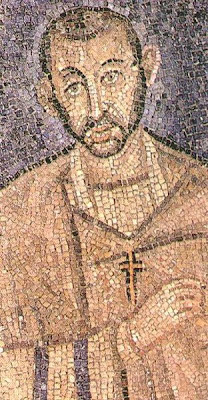 |
| St. Ambrose |
Chant is the foundation of Western music and why that came to be is rather interesting. Turns out that political considerations were crucial. In the 8th century the pope, Stephen II, had to ask Pepin the Short, King of the Franks, for protection against the Lombards who were threatening Rome. Pepin agreed and this collaboration led in time to an alliance between the Franks, soon to be led by Charlemagne, Pepin's son, and Rome, whose then pope, Leo III, would crown him ruler of the Holy Roman Empire. This led to a happy time, the Carolingian renaissance, and the growth and stabilization of many civilized institutions. A system of education was developed and, in order to enable the standardization and dissemination of the chant of the church, the first practical musical notation was created. What we use today is at the end of a long period of development and improvement of this same notation.
The northern Franks practiced the Gallican Rite at the time and this was replaced by Roman liturgical texts and, at first, the melodies used with them. At this time, Christian worship was largely sung--one sang to the Lord, one didn't chat with Him. Suppressing the Gallican rite and replacing it with Roman was easy to do with the text, but harder when it came to the music. In order to teach everyone to sing the same melodies in the same way, a better method had to be found than just teaching by rote, which was the only one available at the time. No-one thought it was sufficiently important to write about at the time, so we don't know exactly where and how it happened, but this was when melodies began to be written down and it was the Franks who started the process.
The Franks took to all this with delight and soon ended up shaping the music and texts of the liturgy to their own musical tastes and gifts. This repertoire is what we now call 'Gregorian' chant even though Gregory I himself had only an indirect role. Left by the wayside in this process were three kinds of non-Gregorian chant. The first of these is the so-called "Old Roman" chant which was the original manner of singing practiced in Rome while the Franks were developing their repertoire and figuring out how to write it down.
Old Roman, Tecum principium:
Another area in which an older tradition of chant still held on (and does to this day) was Milan, the seat of St. Ambrose in the 4th century and the chant is called Ambrosian. Here is another Tecum principium from that repertoire:
Separated geographically and by the Muslim invasion in the 8th century is the Mozarabic chant of the Iberian peninsula. Here is a Beatus vir:
And finally some of that music that the Franks were so creative in developing. This is music from the earliest Frankish music handbook we have, the Musica enchiriadis (written between 860 and 900 AD) and as you will hear, this is the first time we have simple polyphony written down. For much of the first part, two voices are heard. Sorry about the video! This was the best example I could find.




0 comments:
Post a Comment